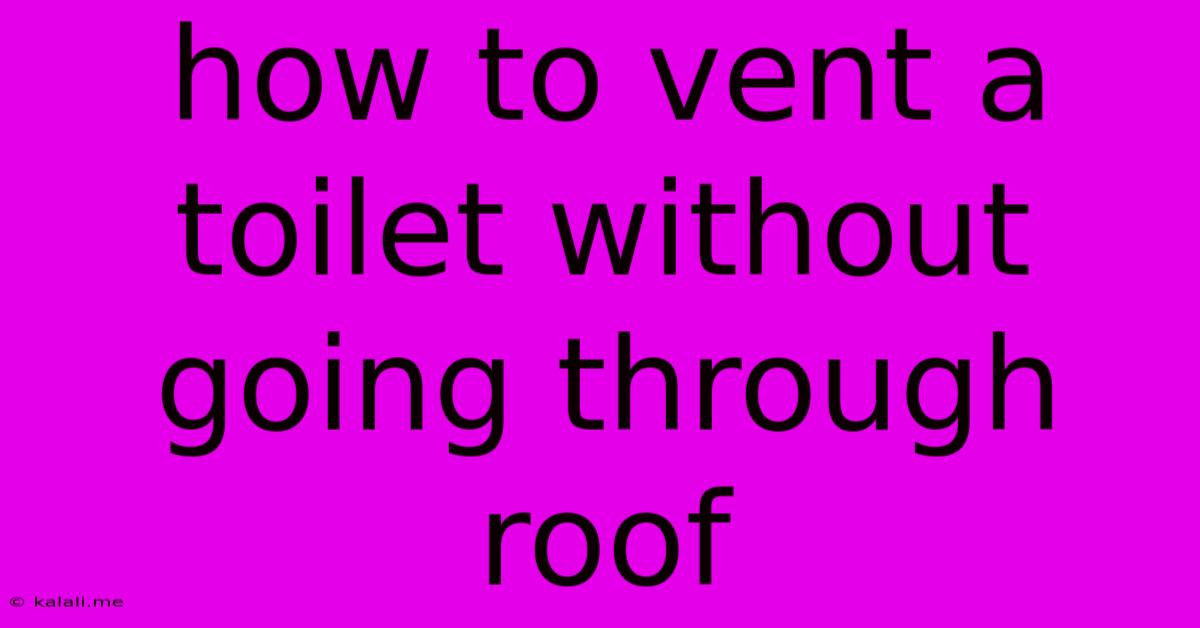How To Vent A Toilet Without Going Through Roof
Kalali
Jun 08, 2025 · 3 min read

Table of Contents
How to Vent a Toilet Without Going Through the Roof: Alternative Venting Strategies
This article explores effective methods for venting a toilet without the need for roof penetration, a common concern for homeowners facing venting challenges. A properly vented toilet is crucial for efficient flushing and preventing sewer gases from entering your home. While roof venting remains the most traditional approach, several alternatives exist, each with its own advantages and considerations.
Why Avoid Roof Venting? Roof penetration can be costly, especially on multi-story buildings or those with complex roofing systems. It can also compromise the roof's structural integrity and lead to potential leaks. Furthermore, aesthetic concerns may make roof venting undesirable for some homeowners.
Understanding Toilet Venting Basics
Before delving into alternatives, it's essential to grasp the fundamentals of toilet venting. The vent pipe allows sewer gases to escape, preventing siphoning and ensuring proper water flow during flushing. A correctly vented toilet prevents unpleasant odors and ensures consistent performance. The goal of alternative venting methods is to achieve the same outcome without the need for a roof vent.
Alternative Venting Strategies
Several effective alternatives to roof venting can be employed, depending on your home's plumbing configuration:
1. Air Admittance Valves (AAVs): These devices are installed on the vent stack and allow air to enter the drainage system, preventing vacuum buildup. AAVs are a relatively inexpensive and simple solution, requiring minimal installation effort. However, they are not suitable for all situations and may require specific sizing to ensure proper functionality. Consider AAVs for smaller applications or as a supplemental vent.
2. Common Venting: This method involves connecting the toilet vent to the vent stack of another fixture, such as a sink or shower, in the same plumbing system. This is particularly efficient when multiple fixtures share a nearby drain line. This shared vent stack effectively equalizes air pressure across the entire system, eliminating the need for a separate toilet vent to the roof. Ensure compliance with local plumbing codes when implementing common venting.
3. Studor Vents: Similar to AAVs, Studor vents automatically equalize pressure within the drainage system. However, they are designed to operate more effectively in a broader range of conditions, including situations where significant pressure fluctuations may occur. They are known for their reliability and low maintenance requirements. Studor vents offer a robust and low-maintenance alternative to roof penetration.
4. Loop Venting: This more complex method involves creating a loop in the vent pipe, routing it back to the main drain line. While effective in some situations, it requires careful planning and execution to ensure proper air circulation within the drainage system. This method is generally only suitable for certain plumbing configurations and may necessitate changes to the existing plumbing setup. Loop venting usually needs professional plumbing expertise due to its complexity.
Choosing the Right Venting Method
The best alternative to roof venting will depend on several factors:
- Plumbing Configuration: The layout of your existing plumbing system will significantly impact the feasibility of different venting methods.
- Local Building Codes: Always check local plumbing codes and regulations before undertaking any changes to your plumbing system. Compliance is crucial.
- Number of Fixtures: The number of fixtures connected to the same drainage system will influence the efficiency of common venting.
- Budget: Consider the cost of materials and installation for each method.
Consult a qualified plumber: Before attempting any significant changes to your home's plumbing system, consult a qualified and licensed plumber. They can assess your specific situation, recommend the most appropriate venting method, and ensure the work is performed correctly and safely, avoiding potential problems. This professional help ensures compliance with building codes and protects against costly mistakes.
This comprehensive guide helps you understand different ways to vent a toilet effectively without resorting to roof penetration. Remember to always prioritize safety and comply with building codes.
Latest Posts
Latest Posts
-
Reading A Bff File In Shell Command Line
Jun 08, 2025
-
What Should Humidity Be Inside House
Jun 08, 2025
-
How To Apply A Texture To A Model In Blender
Jun 08, 2025
-
Can Any E Mount Lenses Be Used On Sony
Jun 08, 2025
-
Lyrics A Hard Rains Gonna Fall
Jun 08, 2025
Related Post
Thank you for visiting our website which covers about How To Vent A Toilet Without Going Through Roof . We hope the information provided has been useful to you. Feel free to contact us if you have any questions or need further assistance. See you next time and don't miss to bookmark.